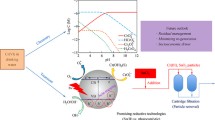Abstract
A study has been conducted on the transformation of Cr(III) and Cr(VI) in simulated natural water conditions. It has been found that these forms are readily interconvertible under natural water conditions. The results of this study indicate that Cr(VI) is reduced by Fe(II), dissolved sulfides, and certain organic compounds with sulfhydryl groups, while Cr(III) is oxidized by a large excess of MnO2 and at a slow rate by Oz under conditions approximating those in natural waters. Based on the results of these studies, water quality standards for Cr should be based on total Cr rather than on Cr(VI), as has been frequently done in the past.
Similar content being viewed by others
References
American Public Health Association, American Water Works Association and the Water Pollution Control Federation: 1971, Standard Methods for the Examination of Water and Wastewater, 13th Edition, APHA, New York, N.Y., U.S.A.
Canter, L. W. and Gloyna, E. F.: 1967, Radioactivity Transport in Water - Transport of Cr-51 in an Aqueous Environment, Civil Engr. Dept., Univ. of Texas, Austin, Tex., U.S.A.
Chuecas, L. and Riley, J. P.: 1966, Anal. Chim. Act. 35, 240.
Copeland, R. A. and Ayers, J. C.: 1972, ‘Trace Element Distributions in Water, Sediment, Phytoplankton, Zooplankton, and Benthos of Lake Michigan’, Envir. Res. Group Spec. Rep. 1.
EPA Proposed Criteria for Water Quality: 1973, U.S. Envir. Prot. Agen., Washington, D.C., U.S.A.
Federal Water Pollution Control Administration: 1968, ‘Report of the Committee on Water Quality Criteria’, U.S. Dept. of the Int., Washington, D.C., U.S.A.
Krauskopf, K. B.: 1956, Geochim. Cosmochim. Acta 9, 1.
Latimer, W. M.: 1952, Oxidation Potentials, 2nd ed., Prentice-Hall, Inc., Englewood Cliffs, N.J., U.S.A.
McKee, J. E. and Wolf, H. W.: 1963, Water Quality Criteria, 2nd ed., State Water Qual. Control Bd., Sacramento, Calif., U.S.A.
Pourbaix, M.: 1966, Atlas of Electrochemical Equilibria, Pergamon Press, London.
Shirnp, N. F., Scheicher, J. A., Ruch, R. R., Heck,D. B., and Leland, H. V.: 1971, ‘Trace Element and Organic Carbon Accumulations in the Most Recent Sediments of Southern Lake Michigan’, Ill. State Geol. Surv. Environ. Geol. Notes 41 (6).
Sillen, L. G. and Martell, A. E.: 1964, ‘Stability Constants of Metal-Ion Complexes’, Special Pub. No. 17, The Chem. Soc. (London).
U.S. Public Health Service: 1962, ‘Public Health Service Drinking Water Standards’, U.S. Pub. Health Ser.
Author information
Authors and Affiliations
Rights and permissions
About this article
Cite this article
Schroeder, D.C., Lee, G.F. Potential transformations of chromium in natural waters. Water Air Soil Pollut 4, 355–365 (1975). https://doi.org/10.1007/BF00280721
Received:
Revised:
Issue Date:
DOI: https://doi.org/10.1007/BF00280721




